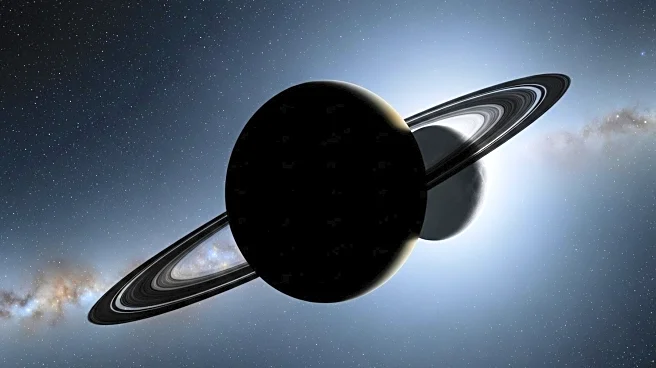What's Happening?
Astronomers using the James Webb Space Telescope have discovered a planet-forming disk around a star in the NGC 6357 region that is rich in carbon dioxide rather than water. This finding challenges existing theories about planetary formation, which typically involve water-rich environments. The star, known as XUE 10, is located 8,000 light-years from Earth. The discovery suggests that ultraviolet radiation or specific local environmental conditions may be depleting water in the disk, leaving carbon dioxide as the dominant compound. This observation could reshape understanding of how Earth-like planets form.
Why It's Important?
The discovery of a carbon dioxide-rich disk around a star challenges prevailing theories of planet formation, which assume water is a key component in the process. This finding has significant implications for the field of astronomy and our understanding of planetary systems. It could lead to a reevaluation of how planets similar to Earth develop and the conditions necessary for their formation. For the U.S. scientific community, this discovery opens new avenues for research and exploration, potentially influencing future space missions and the study of exoplanets.
What's Next?
Further investigation into the star system in NGC 6357 is expected to provide more insights into the formation of Earth-like planets. The James Webb Space Telescope will continue to play a crucial role in observing these phenomena, while upcoming ground-based observatories like the Extremely Large Telescope and upgrades to the Atacama Large Millimeter/submillimeter Array will enhance capabilities to study distant star-forming regions. These efforts will help scientists understand the root causes of unusual disk compositions and their implications for planet formation.
Beyond the Headlines
The discovery of a carbon dioxide-rich disk may have broader implications for the search for extraterrestrial life. Understanding the chemical makeup of planet-forming environments could inform the search for habitable planets and the conditions necessary for life. Additionally, this finding may influence the development of new technologies and methodologies in astronomy, driving innovation in the field. It also highlights the importance of international collaboration in space exploration, as researchers from various countries contribute to the study of distant celestial phenomena.











